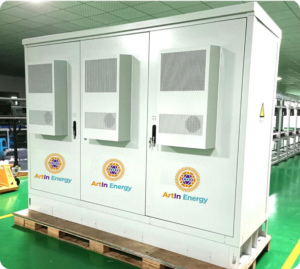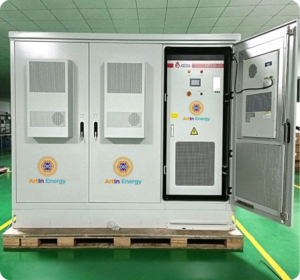BESS Land Requirements & Rates 2024
Battery Energy Storage Systems (BESS) are rapidly emerging as a critical component of the renewable energy landscape. As the demand for clean and reliable energy grows, BESS plays a crucial role in ensuring grid stability and optimizing energy utilization.
Land requirements are a significant factor in the development of BESS projects. Understanding the land needs, lease rates, and other related considerations is essential for project feasibility and profitability. So, let’s explore all the details associated with BESS projects in 2024.
At ArtIn Energy, we offer comprehensive BESS solutions, including site selection and land acquisition services. Our expertise can help you navigate the complexities of BESS land requirements and maximize the return on your investment. Contact us to learn more about how ArtIn Energy can assist you in your BESS project.
Key Takeaways
- Increase in Lease Rates: The increasing demand for BESS projects has driven up land lease rates, making it a valuable asset for landowners.
- Comprehensive Site Evaluation: Factors such as acreage, grid connection, environmental impact, and alternative land uses should be considered when assessing a site’s suitability for a BESS project.
- Strategic Partnerships: Collaborating with experienced BESS developers like ArtIn Energy helps to navigate the complexities of land leasing and project development.
- Favorable Lease Terms: Understanding market rates, project requirements, and legal protections is essential for maximizing the financial returns from land leases.
How Do Battery Storage Projects Work?
A Battery Energy Storage System (BESS) is a sophisticated technology that plays a crucial role in optimizing the utilization of renewable energy sources. It stores excess electricity generated from renewable sources like solar and wind power for later use when demand is high, or supply is low.
BESS operates on a simple principle: it charges when electricity is abundant, typically during periods of low demand or high renewable energy generation. When energy prices rise or supply is constrained, the stored energy is discharged to meet demand, helping to stabilize the grid and reduce reliance on fossil fuels.
Key Components of a BESS:
- Battery System: The core component, comprising individual cells arranged in modules and packs, stores electrical energy.
- Battery Management System (BMS): Monitors and controls battery performance, ensuring optimal charging, discharging, and safety.
- Power Conversion System (PCS): This system converts direct current (DC) electricity from the battery into alternating current (AC) for grid integration or local consumption.
- Energy Management System (EMS): Oversees the overall operation of the BESS, optimizing energy storage and discharge based on grid conditions and market signals.
BESS offers several advantages, including:
- Grid Stabilization: Helps balance fluctuations in electricity supply and demand.
- Peak Shaving: Reduces electricity costs by storing energy during off-peak hours and discharging during peak demand periods.
- Renewable Energy Integration: Enables greater utilization of renewable energy sources by storing excess power for later use.
- Black Start Capability: Can provide backup power during grid outages.
Leasing Considerations in Solar BESS Projects
Land is the most important resource for the development of battery energy storage systems. Several factors must be considered when considering the leasing of a site for a BESS project, some of the most important being:
Acreage and Site Selection
The size of the land required for a BESS project depends on the capacity of the battery system. Factors such as battery technology, energy density, and project scale will determine the necessary land area. Additionally, the site’s topography, soil conditions, and accessibility should be assessed to ensure optimal project feasibility.
Connection to Grid Infrastructure
Proximity to existing grid infrastructure is essential for BESS projects. A strong grid connection allows for efficient energy transfer and grid stabilization services. Factors such as substation capacity, transmission line availability, and grid congestion should be evaluated during site selection.
Environmental and Zoning Considerations
Environmental impact assessments and compliance with local zoning regulations need to be considered for any size of BESS project development. Landowners must ensure that the project adheres to environmental protection standards and obtains necessary permits and approvals.
Alternative Uses for Your Land
Consider the potential for dual-use or multi-use land applications. For example, agricultural activities or livestock grazing can coexist with a BESS project, maximizing land utilization and generating additional revenue streams.
Contract Length and Terms
Negotiating favorable lease terms is essential for landowners and lessees. Factors such as lease duration, rental rates, termination clauses, and land restoration obligations should be carefully considered. It’s advisable to seek legal counsel to protect every party’s interests and ensure the contract aligns with long-term goals.
BESS Lease Rates
Determining appropriate lease rates for BESS projects is a complex process influenced by various factors, including land value, location, project size, market demand, and all aspects mentioned before. While there’s no standardized rate, understanding the broader market trends can provide valuable insights.
The increasing demand for land suitable for solar and battery storage projects has driven up lease rates in recent years, especially because of the incentives offered by the IRA Renewable Energy. As the industry expands, competition for land is intensifying, particularly in regions with favorable solar and wind resources.
Recent research by Purdue University revealed that the average lease rate for solar projects has exceeded $1,000 per acre in many regions. With the growing interest in BESS projects, it’s reasonable to expect similar trends in land lease rates for battery storage facilities.
Knowing that BESS rates depend on many factors, our team can assist you in determining fair market value, securing optimal lease terms, and maximizing your Solar IRR and ROI. Contact us to learn more.
Incentives for Battery Energy Storage Systems
To encourage the adoption of BESS and support the transition to clean energy, various incentives and programs have been implemented at the federal, state, and utility levels. Understanding these incentives is crucial for maximizing the financial benefits of your BESS project.
Federal and State Incentives
The Inflation Reduction Act (IRA) introduced significant commercial solar tax credits and incentives for clean energy technologies, including BESS. The Investment Tax Credit (ITC), previously applicable to solar projects, has been expanded to include energy storage systems.
The base ITC for energy storage is 6% of the project’s qualifying costs. However, this can be increased to 30% if the project meets prevailing wage and apprenticeship requirements (PWA). To further incentivize domestic production, the Domestic Content Bonus offers an additional 10% ITC for projects using American-made components. And the Energy Communities Bonus provides a 10% ITC bonus for projects located in designated energy communities.
Additionally, the IRA offers the Commercial Clean Vehicle Credit for businesses purchasing electric vehicles, which can indirectly support BESS adoption by increasing electricity demand during off-peak hours.
State-level incentives vary widely, with some states offering tax credits, rebates, grants, or accelerated depreciation for BESS projects. To maximize your project’s financial benefits, it’s essential to research the specific incentives available in your region.
Renewable Energy Credits (RECs)
BESS projects can generate Renewable Energy Credits (RECs) by storing and discharging renewable energy. RECs represent the environmental attributes of renewable electricity generation and can be sold or traded in compliance markets. This provides an additional revenue stream for BESS projects.
Utility and Grid Incentives
Utilities often offer incentives to encourage the adoption of energy storage systems to improve grid reliability and balance supply and demand. These incentives may include demand response programs, time-of-use rate structures, or capacity market participation.
Innovation Grants and Subsidies
Government agencies and private foundations may provide grants and subsidies for research and development of advanced energy storage technologies. These funding opportunities support innovation and accelerate the commercialization of new battery solutions.
Optimize your Solar Battery Energy Storage Project with ArtIn Energy
At ArtIn Energy, we’re leading providers of cutting-edge BESS systems and renewable energy solutions designed to maximize the value of your clean energy investment.
We offer top-notch BESS units that deliver exceptional performance and reliability. Our team of experts will work closely with you to assess your specific needs, optimize system design, and ensure seamless integration with other renewable energy assets and long-term reliability.
By partnering with us, you gain access to:
- In-depth project assessment and feasibility analysis.
- Expert guidance on land acquisition and lease negotiations.
- Guidance on government incentives and financial support.
- Seamless project implementation and management.
- Ongoing maintenance and support.
Contact us to schedule a consultation with our team of renewable energy consultants and explore how ArtIn Energy can empower your business with clean, reliable, and cost-effective energy storage solutions.




